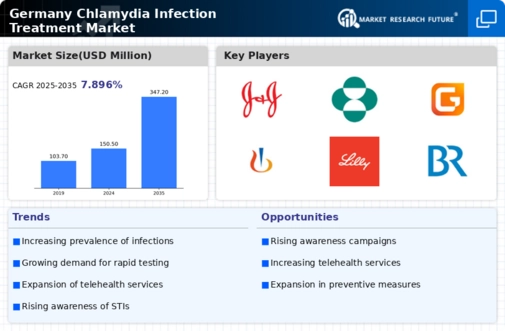Increasing Incidence Rates
The chlamydia infection-treatment market is experiencing growth due to rising incidence rates of chlamydia in Germany. Recent data indicates that the infection rate among sexually active individuals has increased, particularly among young adults aged 15 to 24. This demographic accounts for a significant portion of reported cases, leading to heightened demand for effective treatment options. The German health authorities have reported that approximately 200,000 new cases are diagnosed annually, which underscores the urgent need for accessible treatment solutions. As awareness of the infection's prevalence grows, healthcare providers are likely to prioritize screening and treatment, thereby driving the market forward. This trend suggests that the chlamydia infection-treatment market will continue to expand as more individuals seek medical assistance and treatment options become more widely available.
Rising Healthcare Expenditure
An increase in healthcare expenditure in Germany is contributing to the growth of the chlamydia infection-treatment market. As the government and private sectors invest more in healthcare services, there is a corresponding rise in the availability of diagnostic and treatment options for STIs, including chlamydia. The healthcare expenditure in Germany has seen an annual growth rate of approximately 4%, which is expected to continue in the coming years. This financial commitment allows for better access to healthcare services, including screening and treatment for chlamydia. Consequently, as more resources are allocated to sexual health services, the chlamydia infection-treatment market is likely to benefit from enhanced service delivery and increased patient access to necessary treatments.
Government Initiatives and Funding
Government initiatives aimed at combating sexually transmitted infections (STIs) are playing a crucial role in the chlamydia infection-treatment market. In Germany, public health campaigns and funding for STI prevention and treatment programs have been implemented to reduce the incidence of chlamydia. The government allocates substantial resources to promote awareness, facilitate testing, and provide treatment options. For instance, funding for educational programs has increased by 15% over the past year, which is expected to enhance public knowledge about chlamydia and its treatment. These initiatives not only aim to reduce infection rates but also encourage individuals to seek timely treatment, thereby positively impacting the chlamydia infection-treatment market. The ongoing support from government bodies indicates a commitment to improving sexual health and reducing the burden of STIs in the population.
Technological Advancements in Treatment
The chlamydia infection-treatment market is being influenced by technological advancements in treatment methodologies. Innovations in pharmaceuticals, such as the development of new antibiotics and combination therapies, are enhancing treatment efficacy and patient compliance. Recent studies suggest that novel treatments can reduce the duration of therapy and improve outcomes for patients. Additionally, the introduction of point-of-care testing devices allows for rapid diagnosis and immediate treatment initiation, which is particularly beneficial in outpatient settings. As these technologies become more integrated into healthcare practices, they are likely to drive growth in the chlamydia infection-treatment market. The potential for improved treatment options may lead to increased patient satisfaction and adherence, ultimately contributing to better public health outcomes.
Changing Social Attitudes Towards Sexual Health
Changing social attitudes towards sexual health are influencing the chlamydia infection-treatment market in Germany. There is a growing acceptance of discussing sexual health issues openly, which encourages individuals to seek testing and treatment for STIs. This shift in societal norms is reflected in increased participation in screening programs and a greater willingness to address sexual health concerns. Surveys indicate that approximately 60% of young adults now view regular STI testing as a responsible health practice. As these attitudes continue to evolve, the demand for chlamydia treatment is likely to rise, thereby impacting the market positively. The increased focus on sexual health education and destigmatization of STIs may lead to more proactive healthcare behaviors, further driving the chlamydia infection-treatment market.

























Leave a Comment